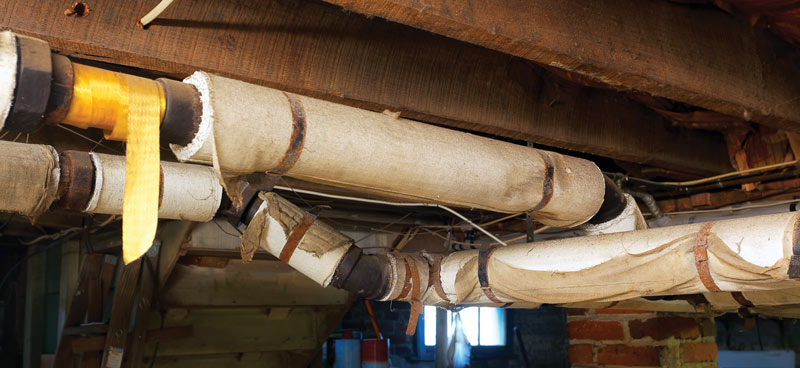
Transite pipe, an asbestos-cement product, was used extensively in potable water systems, irrigation, chimneys and vents in the mid-1900s. Photo by Vincent Noel/Shutterstock.com
Asbestos exposure isn’t generally regarded as an occupational hazard for the golf industry. Workers in the automotive industry, military, construction trades and mining seemed to have the worst of it. Because of its pervasive use in construction materials and subsequent presence in waste streams, however, asbestos continues to persist in many of our work environments. As employers and supervisors, golf course superintendents need to recognize the risks that may expose our workers and or public to this hazardous material.
Asbestos 101
Asbestos is a naturally occurring mineral with incredible tensile strength and heat and flame resistance. Because of these qualities, it was widely used in the 1940s through the 1970s in concrete, insulation, tiles, adhesive, transite pipe and other construction materials.
Asbestos exposure can result in lung diseases and a specific lung cancer called mesothelioma. Once inhaled, asbestos fibers reside deep in the lungs. Cells form around the fiber, causing scar tissue and disease.
When I initially heard about asbestos-containing materials in today’s workplace, I seriously thought, “What’s the big deal?” It was banned decades ago, and I work in golf, so there must be zero risk of me encountering this material. I see the legal ads for mesothelioma claims, but have never thought it would happen to me, because asbestos exposure is not my workplace hazard. I was wrong.
Facts about asbestos in the workplace
- Asbestos isn’t banned in the United States. Products that have historically contained asbestos and contain less than 1 percent asbestos are permitted in the U.S. See U.S. Federal Bans on Asbestos on the EPA’s website for a list of some of the asbestos-containing products that are banned and those that aren’t.
- The less-than-1-percent standard does not guarantee your safety. Exposure to minute amounts of asbestos can result in disease.
- Repairing or remodeling a structure built before 1985 or so? It’s best to assume that the drywall, joint compound, insulation, glue, pipe insulation, etc., may have asbestos. Before you demo or remodel a building, get it tested for asbestos.
- Transite pipe contains asbestos and is pervasive in mid-century construction. Transite pipe was used in irrigation, chimneys and vents. This pipe is still functioning in many applications today. Have you ever been digging and found old irrigation pipe that looked like it was coated in concrete or fibrous material? It was likely transite pipe. Don’t overlook this product and the hazard it poses.
- Did your facility used to bury construction waste from a bygone era? Did you find a pile of buried construction waste when digging out that new bunker? These materials may contain asbestos, and when disturbed, they expose workers and contaminate surrounding soils.
- Be aware of products containing vermiculite. Vermiculite itself is not deemed hazardous, but because it is mined in areas closely associated with asbestos minerals, vermiculite may contain asbestos. The EPA offers more information on contaminated vermiculite insulation.
What superintendents can do
“Call before you dig” is a common best management practice for all excavation activities. How about “If you suspect it, you test it” for asbestos? Not as catchy, but worth repeating often enough to make it another standard best management practice to reduce exposure to asbestos hazards in your home and work projects.
There are businesses that specialize in the identification, cleanup and disposal of asbestos. It is cheaper to catch an asbestos hazard before you disturb the material. Costs for cleanup multiply greatly after it has been disturbed and deposited in the soil and surrounding site.
If the health risks aren’t scary enough to cause you a “Suspect it, test it” moment, then consider the regulations and fines associated with improper handling of asbestos-containing products. Fines levied by states and municipalities for failing to properly abate asbestos can quickly climb into the hundreds of thousands of dollars, making the cost of planning and abatement a worthwhile financial endeavor.
Have a demo or remodel project coming up and not sure about the building materials? Have them tested before you begin work. Dig up suspect materials? Stop work and call in an expert to test. If it contains asbestos, have the abatement professionals remove it. Educate your staff on the dangers of asbestos by scheduling annual training with an occupational health and safety professional. As stewards of our workplace and environment, we can do our part to make certain asbestos is not one of our occupational hazards.
Pamela C. Smith, CGCS, is an attorney and director of agronomy for a large city. She is a 27-year member of GCSAA.